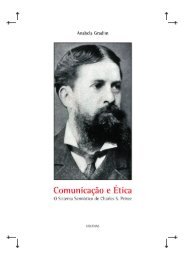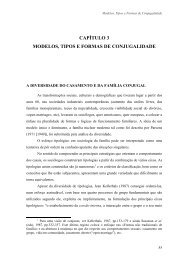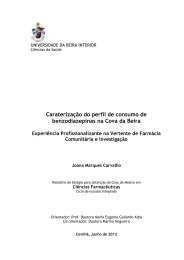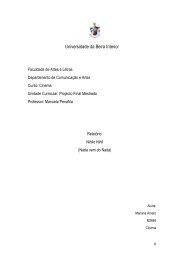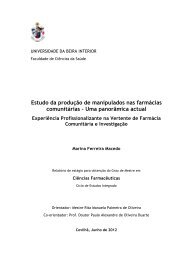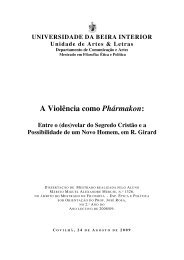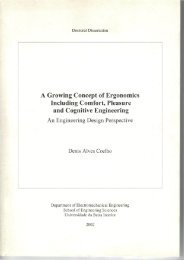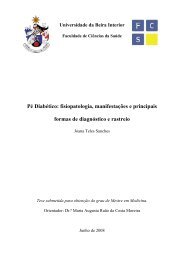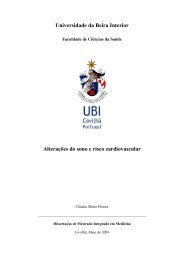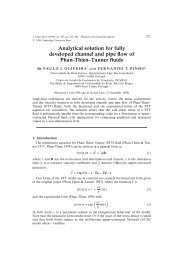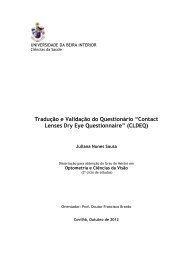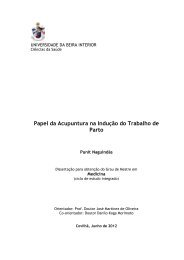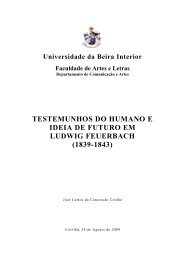Tese_Tânia Vieira.pdf - Ubi Thesis
Tese_Tânia Vieira.pdf - Ubi Thesis
Tese_Tânia Vieira.pdf - Ubi Thesis
Create successful ePaper yourself
Turn your PDF publications into a flip-book with our unique Google optimized e-Paper software.
Chapter II – Materials and Methods<br />
2.2.6. Nanoparticles Fourier Transform Infrared Spectroscopy Analysis<br />
The different nanoparticles were also analyzed by FT-IR. This spectroscopic tool gives<br />
information about the molecular structure of chemical compounds, and it is useful for the<br />
characterization of biopolymers (Lawrie et al. 2007). The spectra was acquired in a Fourier<br />
transform infrared spectrophotometer Nicoletis 20 (64 scans, at a range of 4000 to 400 cm -1 )<br />
from Thermo Scientific (Waltham, MA, USA) equipped with a Smart iTR auxiliary module.<br />
2.2.7. Determination of antibacterial activity<br />
2.2.7.1. Minimum Inhibitory Concentration and Minimal<br />
Bactericidal Concentration<br />
The antimicrobial activity of the synthesized AgNPs was assessed through a standard<br />
microdilution method, in order to determine the Minimum Inhibitory Concentration (MIC), which<br />
is defined as the lowest concentration of material that inhibits the growth of an organism. This<br />
assay was performed in agreement with the standards recommendations from the National<br />
Committee for Clinical Laboratory Standards (NCCLS). The antimicrobial activity of AgNPs was<br />
scrutinized using E. coli as a model of Gram-negative bacteria, in a 96 wells plate. The AgNPs<br />
were diluted several times with 100 µL of culture medium (LB Broth). After that, 100 µL of<br />
culture medium inoculated with the tested bacteria at a concentration of 2.5×10 5 colony-forming<br />
unit (CFU)/mL was added to the plate. A negative control was prepared with 200 µL culture<br />
medium and a positive control was set by using 100 µL of culture medium inoculated with 100 µL<br />
of the bacteria at a concentration of 2.5×10 5 CFU/mL. The plate was incubated 24 h at 37 °C and<br />
then the MIC of the tested substance was determined (Panác ek et al. 2006). This test was done<br />
in triplicate.<br />
The Minimal Bactericidal Concentration (MBC) may be characterized as the minimum<br />
concentration of the sample required to achieve bacterial dead after 24 h of incubation. The<br />
MBC was examined by a modified imprinted method. 5 µL of the tested samples with defined<br />
concentrations were transferred from the plate wells and imprinted on the surface of a plate of<br />
LB agar without antimicrobial agents. Then the petri plate was incubated for 24 h at 37 °C and<br />
the MBC was determined as the lowest concentration that inhibited the bacterium visible growth<br />
(Panác ek et al. 2006). The nanoparticle concentration causing bactericidal effect was<br />
determined based on the absence of colonies on the agar plate (Ruparelia et al. 2008).<br />
23



